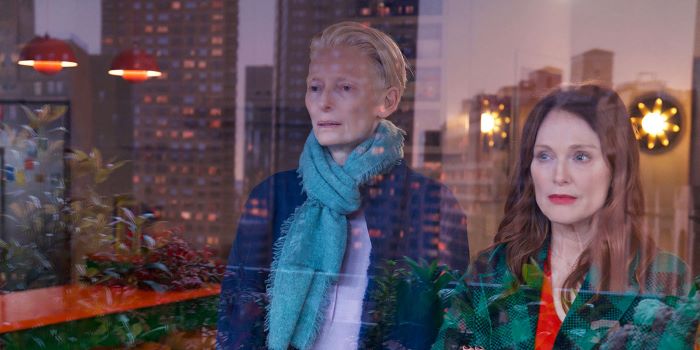The opening shot of Pedro Almodóvar’s first English-language feature offers a clue to its intellectually oriented ambitions: a freeze-frame of Rizzoli’s, a bookstore destination in Manhattan’s Flatiron district. Get ready for the literary references.
The Spanish filmmaker has based the screenplay on the 2020 novel What Are You Going Through by Sigrid Nunez and has imbued it with highfalutin English—a cynic may think it sounds like an AI translation of a 19th-century French novel. (Those who have worked in New York publishing, myself included, may find it a bit foreign that anyone working today at, say, the New York Times would repeatedly use words more commonly found in an E. M. Forster novel.) The dialogue is self-consciously erudite. The director aims for both the heart and the intellect.
At a signing for her latest nonfiction book, Ingrid (Julianne Moore) encounters a gushing friend in line, Stella (Sarah Demeestere), who, after the preliminaries, tells her the news of their longtime friend, Martha (Tilda Swinton), who has cervical cancer. Stella reassures Ingrid that Martha would love a hospital visit, though it has been years since they’ve seen each other. Ingrid and Martha first met working in the high-energy 1980s New York for Paper magazine before Martha’s career as a war correspondent for the New York Times. On the front lines, she faced death on a daily basis. (In explaining to Stella why she wrote her latest book, Ingrid says she has explored the topic of death because it “feels unnatural.” The movie’s theme will be nothing but conspicuous.)
The Room Next Door will have its U.S. premiere at the New York Film Festival at Lincoln Center. It’s more than an appropriate venue, given the festival’s decades-long support of the filmmaker, and viewers will feel part of the in-crowd when Ingrid and Martha attend an Ingrid Bergman retrospective at Alice Tully Hall, where The Room Next Door will screen on October 4. Here Martha pops the question to the always gracious, always agreeable, always accommodating Ingrid: to help her die with dignity. Martha’s last experimental treatment has failed, and she wants to forego any further treatment. Her decision has been firmly set, a decision of the mind, less so than the heart. (“I should never have given in to false hope.”) The focus then turns toward Ingrid and her hesitancy and qualms about her friend’s request—this scenario would certainly play out differently in the 10 states where medical-assisted suicide is legal.
Whether willingly or reluctantly, viewers will become acclimated to Martha’s wordy pronouncements: “I am struck by the symmetry of their deaths;” “All pleasure has been reduced;” “This breeze is delicious.” She even quotes James Joyce. If the director’s 1989 comedy Women on the Verge of a Nervous Breakdown could become a Broadway musical, then it’s not too difficult to imagine this scenario as a two-hander onstage. More so than in many of his other films, the action centers on two people talking in well-appointed rooms. The only other person featuring prominently is John Turturro as Damian, a former lover of both women. Ingrid broke up with him before he moved on to Martha. Unlike so many new works coming out the fall festivals involving heavy material—abortion (April), life after the Holocaust (The Brutalist)—Almodóvar adds levity in Damian’s blunt screed against overpopulation.
However, much of the conversation between the two women comes across as cocktail/getting reacquainted polite chit-chat. There’s little conflict in the dialogue, in which the two are frankly dismissive or angry toward each other. Martha’s objective to die a peaceful death is made matter-of-factly, sans reservations or a confrontation that might challenge her will. The whole affair remains genteel. Except for the contemporary references, the scenario would have played well in the 1940s with Joan Crawford/Greer Garson or Bette Davis/Olivia De Havilland. (Digressive flashbacks to Martha’s relationship with her daughter’s father wouldn’t have been so out of place in a mid-century woman’s picture.)
This is Almodóvar at his most straightforward, a modest film without flash, save for the color-coordinated art direction. The soothing colors and the second act’s mountainous setting in the Catskills (actually, Spain) dispel melancholia, and the tone becomes steadily seductive. In keeping with the copacetic look and the elegant repartee, Almodóvar tosses in a touch of moviemaking magic that has been used as a form of closure/benediction. It can be seen in the conclusion of the 1934 Joan Crawford vehicle Sadie McKee and as a sign of the transition of time in Douglas Sirk’s All That Heaven Allows (1955): the special effect of falling snow, doubling as a grace note, accompanying a reading of Joyce (The Dead, what else?).

















Leave A Comment